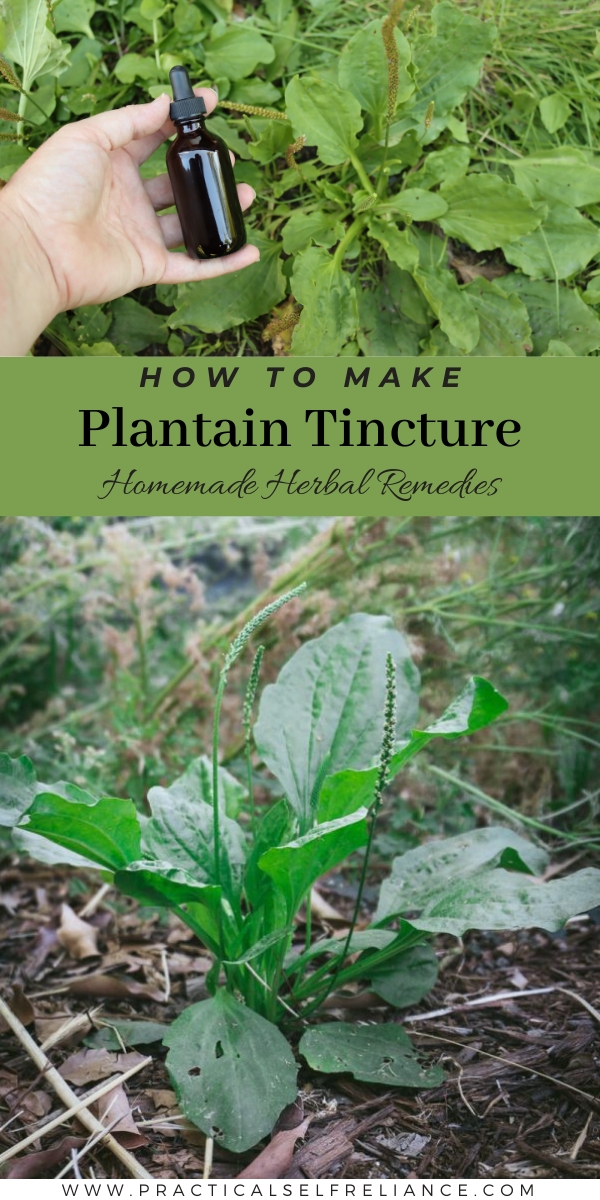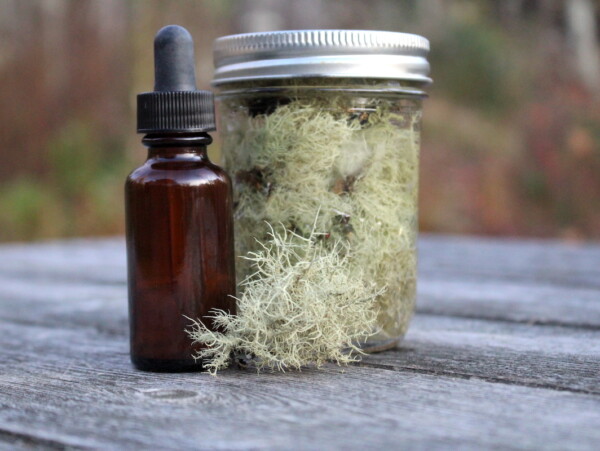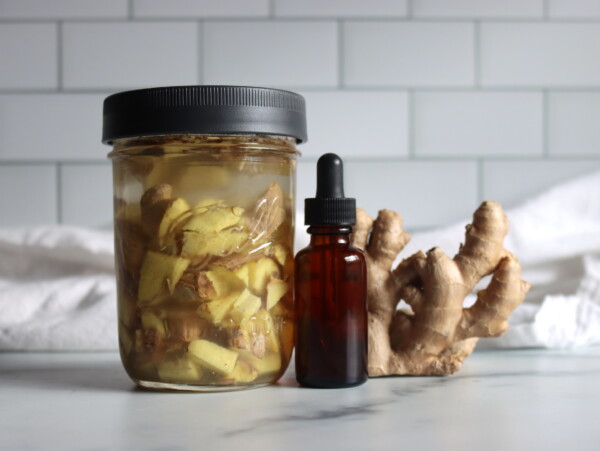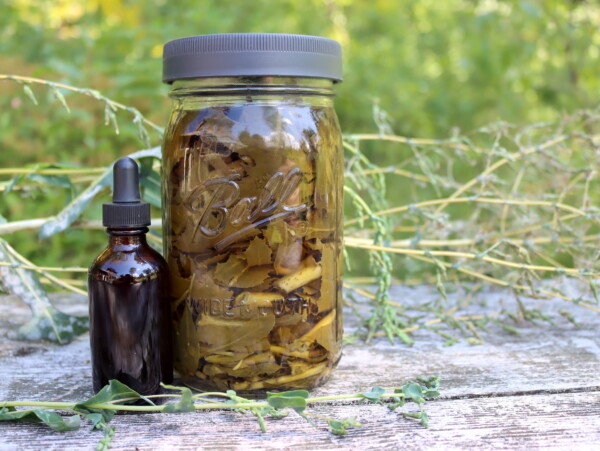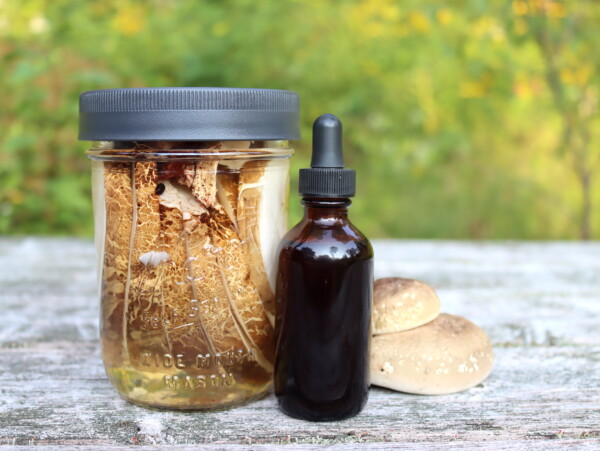Affiliate disclosure: This post may contain affiliate links. Please see our Privacy Policy.
Like the fresh herb, plantain tincture is an excellent soothing, anti-inflammatory remedy for bug bites, stings, and other skin irritations. It also has some impressive properties for internal health. Plantain tincture may help support digestive health, promote wound healing, decrease inflammation, treat coughs, and relieve cramps. Plantain tincture is a wonderful multi-purpose remedy to have on hand and is easy to make at home.

Plantain is probably best known as a bug bite and sting remedy for hikers and homesteaders out in the field. Simply chewing or crushing the plant and plastering it on the skin can help soothe irritation. We make plantain salve every year so we can use this wild medicinal year round, even when snow’s covering the ground.
The tincture has some similar properties for external use but stores for an extended period and is easy to keep on hand. As a tincture, it’s also easy to use for its internal benefits, particularly its antispasmodic, soothing properties on diarrhea, cramps, and other stomach ailments.
One of the best things about plantain is how easy it is to find. Plantain is one of those herbs that seems to follow people wherever they go. It’s common to find plantain growing in yards, parks, pastures, abandoned lots, gardens, and along roadsides.
(Here’s how to Identify Plantain out in the wild.)
Avoid harvesting your plantain from areas that may be contaminated with exhaust fumes, herbicides, or other contaminants.
There are over two hundred species of plantain (Plantago). In the United States, we have several native plantain species like American Plantain (Plantago rugelii) and California Plantain (Plantago erecta). We also have many naturalized species, including Broadleaf Plantain (Plantago major) and Lance Leaf Plantain (Plantago lanceolata).
If you don’t find a plantain species growing on your property and would like to grow some, you can cultivate plantain. As a weedy species, it’s easy to grow, and you can direct sow seeds you purchase online or gather from nearby plants.
Plantain is great to have around for people and wildlife. Some plantain species, like the California Plantain, are important host plants for the larval or caterpillar stage of native butterflies.
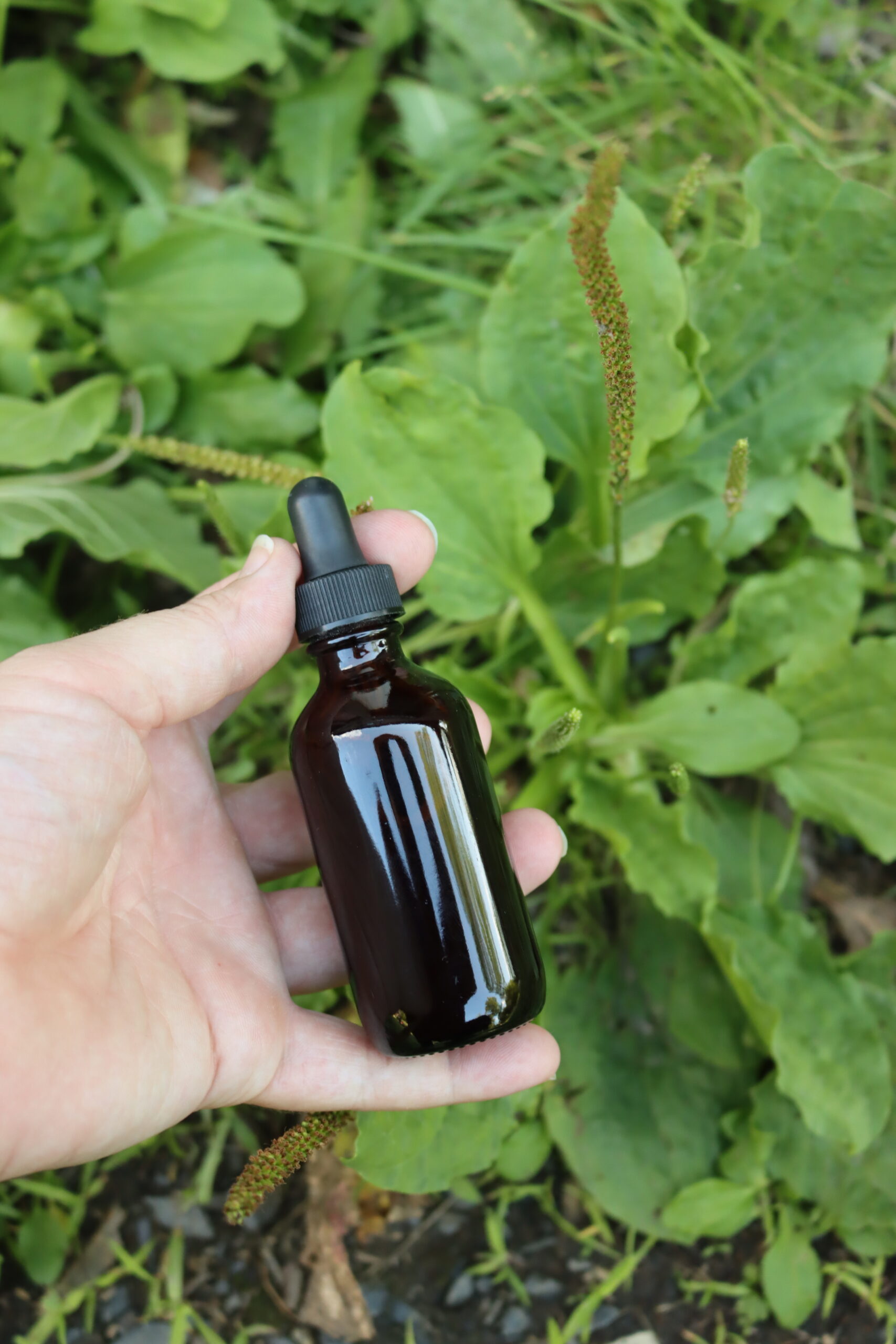
(Always consult your doctor or a clinical herbalist before trying any new herbal remedy, as there’s always the possibility of unintended consequences, allergic reaction, or interactions with other medication. If you’re harvesting wild plant material, make sure you’re 100% confident in your identification and consult multiple sources for your ID. The following is based on my research and experience, but I don’t claim to have any certifications that would qualify me to advise you on your health. Please do your own research and always verify with multiple reputable sources.)
Plantain Tincture Uses
Herbalists use plantain tinctures both topically and internally to treat a variety of ailments.
Topically, plantain tincture is used for:
- Soothing Bug Bites and Stings
- Healing Minor Cuts and Wounds
- Reducing Inflammation
Internally, plantain tincture is used to:
- Support Digestive Health
- Treat Diarrhea and Other Digestive Issues
- Reduce Inflammation and Speed Wound Healing
- Treat Coughs and Respiratory Ailments
Additionally, the herb is currently being investigated for its potential:
- Fight Cancer
In these cases, research is ongoing, and more work is needed to establish whether or not the benefits are scientifically significant.
Benefits of Plantain Tincture
Plantain has played a significant role in folk medicine for centuries, which is part of the reason it is so widespread today. Many European settlers brought plantain with them as they colonized North America and other lands.
Much of plantain’s common use has been on external wounds, bites, stings, and other skin irritations. Several animal studies have supported these uses. A 2018 study on mice showed that topical application of plantain positively affected wound healing. A similar study using plantain and aloe on wounded mice found that the mice that received the plantain and aloe treatment showed faster wound closure.
Further, a 2019 study examined the effect of combining aloe vera and plantain to topically treat diabetic foot ulcers. The researchers found that the patients who received the plantain and aloe vera treatment showed a significant reduction in ulcer area compared to the placebo.
Many cultures have also relied on plantain species to help support digestive health and soothe and heal stomach issues. Modern research supports many of these uses. One study from 2018 found that rats with ulcers who were given doses of plantain seed extract had significantly less stomach and liver damage than rats given a placebo. Other animal studies have indicated that plantain’s anti-inflammatory properties may help treat digestive issues, including Inflammatory Bowel Disease (IBD).
Plantain may also help treat coughs and respiratory issues. One 2006 study treated guinea pigs with plantain spray or saline spray. Those animals that received the plantain spray had a significant reduction in coughs. Plantain is also a major ingredient in some commercial cough syrups for children, like KalobaTUSS®, which a 2021 study found effective at reducing the severity and duration of children’s coughs.
Much of plantain’s healing properties may come from its anti-inflammatory compounds. Plantain leaves contain compounds like flavonoids, terpenoids, pectin, iridoid glycosides, and tannins with anti-inflammatory and antioxidant activities. In a study on rats, plantain reduced inflammation from a live injury.
Researchers are also investigating plantain’s anti-tumor properties. In a 2007 study on mice, researchers found that Broadleaf Plantain extract inhibited the growth of Ehrlich ascites tumors. Another mouse study from 2021 found that plantain may also promote the maturation of Dendritic cells, which help improve immunity to breast cancer. However, research is ongoing, and plantain shouldn’t be used as a replacement for cancer treatment.
Plantain tincture generally has few side effects and is a relatively mild herbal remedy. However, some people who are sensitive or allergic to plantain may have skin reactions when used externally or nausea and vomiting when used internally. If you have never used plantain before, start with a small amount.
Plantain tincture doses vary depending on the intended purpose. Start with a small amount. Topically, you can use plantain tincture as a spray or dab it on the affected area. For internal use, take ½ to 1 dropper full up to three times daily.
Parts Used for Tincture
Plantain is one of many herbs in which the entire aerial part of the plant, including the leaves, stems, flowers, and seeds, is useful.
The leaves are the most effective part of the herb for topical use and skin healing. However, the compounds in the seeds play a major role in digestive health. You can create a specifically focused tincture or incorporate all parts of the plant more multi-use.
To prepare your plant for tincturing, roughly chop up any leaves, stems, and flowers. Crush the seeds using a mortar and pestle if available. There’s no need to remove the seed husks; they can be included in the tincture. Processing the plant like this creates more surface area and allows the tincture to absorb into the plant material.
Dried plantain also works well for tinctures. You can dry your own plantain until you’re ready to use it, or you can purchase dried plantain leaf from an herbal supplier like Mountain Rose Herbs.
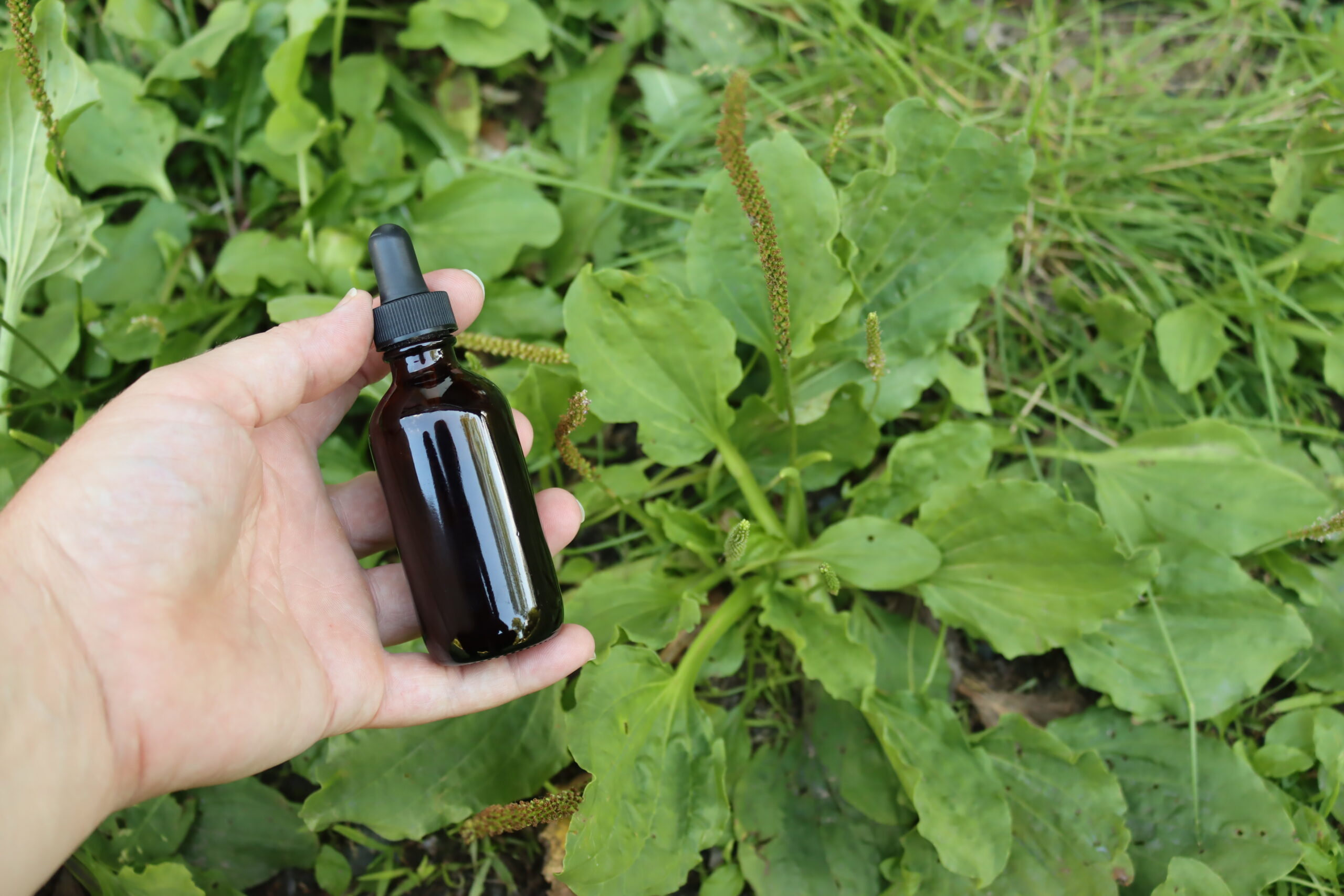
How to Make Plantain Tincture
To make a plantain tincture, you’ll need the following ingredients and equipment:
- Fresh or Dried Plantain
- Vodka* (or your favorite alcohol that’s at least 80 proof/40 percent — it doesn’t need to be an expensive brand)**
- One-pint mason jar with an airtight lid (amber glass is ideal, but as long as you keep the tincture away from light at all times, it won’t make a difference)
- Funnel
- Cheesecloth
- Fine mesh sieve
- Amber glass tincture bottles (with dropper)
*The Herbal Academy’s tincture-making course specifically recommends using 30% alcohol when tincturing dried plantain leaves, seeds, and seed husks. For tincturing fresh herbs, they recommend between 70 and 95% alcohol.
**Never use isopropyl/rubbing alcohol for tinctures (or any other remedy you plan on ingesting). Even in small amounts, this type of alcohol is toxic and meant for external applications only.
First, fill your jar about ½ full with fresh plantain or about ⅔ full with dried plantain. Then, cover your herbs with the alcohol of your choice. They should be fully submerged, but it’s okay if some of the dried herbs float.
Seal your jar with an airtight lid and place it somewhere cool and dark to age. You’ll need to give your jar a gentle shake every day or as often as possible. Every day is ideal, but it’s okay if you miss a few days; tinctures are very forgiving.
You need to keep up this process for about four to six weeks. Then, you can decant your tincture.
Line your funnel with cheesecloth or get a fine mesh sieve to strain out the plant material. Carefully squeeze all the plant material to ensure you get all of your tincture out. If it seems like there’s still a lot of plant material in your strained tincture, you may need to repeat the process with more cheesecloth.
Then, you can bottle your plantain tincture. Tincture bottles with dropper caps are great for internal use or for dropping a specific amount onto a cloth or cotton swab. Alternatively, you can use a small glass spray bottle if you know you’ll be using your tincture externally.
Ideally, you will use amber glass or other tinted bottles. If you have to use a clear bottle, make sure you store your tincture somewhere dark.
Label your bottles with the name, date, and dosage. I like to use a piece of masking tape and marker. It’s easy to remove when I’m ready to reuse the bottle.
Plantain Tincture Dosage
I’d suggest consulting a clinical herbalist for an exact dosage specific to your body and needs, especially if you’re dealing with more serious conditions.
To treat bug bites, stings, and other minor external wounds and irritations, spray or dab your plantain tincture onto the affected area as needed.
For internal use, begin with a low dose to see how your body handles it. Then you can take ½ to 1 dropper full up to three times daily or as needed.
Plantain Formulations
Plaintain often works well in conjunction with other anti-inflammatory, skin-healing herbs. Try pairing it with aloe vera, calendula tincture, jewelweed tincture, or turmeric tincture. When used to reduce internal inflammation and heal digestive ailments, combine plantain with other digestive remedies like ginger tincture, chamomile tincture, or self-heal tincture.
If you’re interested in the science behind combining herbs to enhance their effectiveness, I’d recommend taking this online course in Mastering Herbal Formulations from the Herbal Academy. It covers the science of blending herbs into homemade formulations in detail.
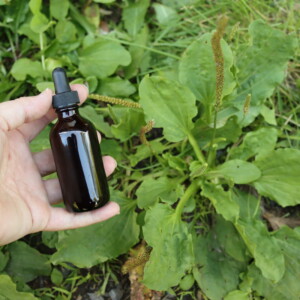
Plantain Tincture
Equipment
Ingredients
- Plantain dried or fresh
- Neutral Spirit such as vodka*
Instructions
- Begin by filling a clean mason jar about three-quarters full with fresh plantain leaves or half-full if you're using dried plantain (dried plantain is commonly available from herbal suppliers). Fresh plantain will yield more liquid, but dried plantain may absorb some of the alcohol, reducing the final yield.
- Pour enough alcohol (vodka, brandy, whiskey, or another high-proof spirit) into the jar to completely cover the plant material. Ensure that the plantain is fully submerged, as this is key to a successful extraction.
- Close the jar tightly with its lid, then gently shake it to help mix the plant material with the alcohol. Store the jar in a cool, dry place away from direct light, and let it sit for 6 to 8 weeks.
- Every few days, give the jar a gentle shake to keep the plant material moving and ensure a consistent extraction. Check periodically to make sure the plant remains submerged; if the level of alcohol drops, simply top it up with more to maintain coverage.
- When the tincture is ready (after 6-8 weeks), set up a funnel lined with cheesecloth over a clean, dark glass bottle. Pour the contents of the jar into the funnel, pressing the plant material to extract as much liquid as possible. The cheesecloth will help filter out the plant material, leaving you with just the tincture.
- Once you've strained the tincture, make sure to label the bottle with the plant’s name, the date of production, recommended dosage, and intended uses. Store the tincture in a cool, dry place, away from sunlight to preserve its potency.
Notes
To make an alcohol-free glycerite tincture (glycerite)
If you prefer an alcohol-free tincture, you can create a glycerite instead. To do this, cover the dried plant material with a mixture of 3 parts vegetable glycerin and 1 part distilled water. For fresh plantain, use pure glycerin without any water. Like an alcohol tincture, the glycerite should be shaken daily during the infusion period. Follow the same steps for straining and storing once the glycerite is ready.Yield
The final yield of your tincture will vary depending on whether you're using fresh or dried plantain. With fresh material, you’ll likely end up with a slightly larger volume of tincture than the amount of alcohol you initially added. If using dried plantain, expect to get a little less than the volume of alcohol you added, as the plant material will absorb some of it. For a quart jar, you will need approximately 2 to 3 cups of alcohol, and for a pint jar, about 1 to 1.5 cups. Always ensure that the plant material stays submerged during the infusion process to avoid oxidation or spoilage.Disclaimer on Homemade Herbal Remedies
I’ve been foraging wild medicines and treating my family with herbal remedies for the past 20 years, but I’m self-taught. Be aware that I am not a clinical herbalist, and this is based on my own research and personal experience using medicinal plants. I do not claim to have the experience that’d qualify me to advise you on your health, and I’m only providing this as a reference to encourage a broader interest in medicinal plants.
Please use this as a jumping-off point, but always do your own research and verify anything you read with multiple sources.
It’s always possible to have an adverse reaction to any medicinal herb, and plenty of people are allergic to even gentle herbs like chamomile. Always consult your doctor or a certified herbalist before trying any new medicinal plant. Often, they can have unintended reactions in combination with other herbs and supplements, and many herbs have side effects even when they are effective for their intended purpose.
If you are seriously interested in herbal medicine, I’d suggest investing in a course in herbal medicine, and I’d recommend any of the online courses put out by the Herbal Academy of New England. Specifically, the introduction to herbal medicine course and the family herbalist group of courses.
They also have a mushroom course, covering both medicinal and edible mushrooms, and a Botany and Wildcrafting Course. I’ve taken both and they’re informative, inspiring, and artfully presented.
Herbal Tinctures
Interested in making other homemade herbal tinctures?
- Yarrow Tincture
- Chickweed Tincture
- Elderberry Tincture
- Dandelion Tincture
- Burdock Tincture
- Echinacea Tincture
Herbal Medicine Making
Herbal medicines don’t stop at tinctures! Learn how to make more homemade medicine…
